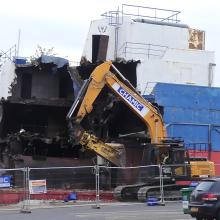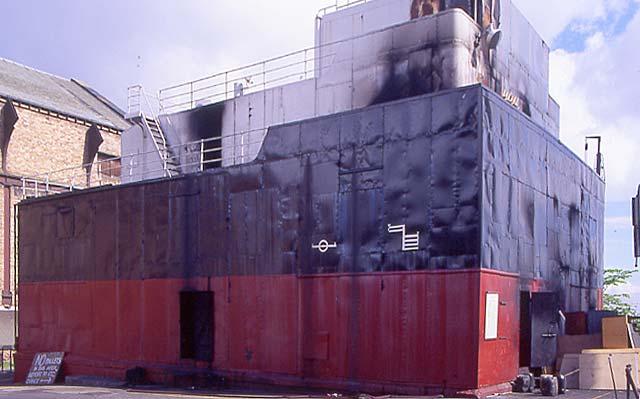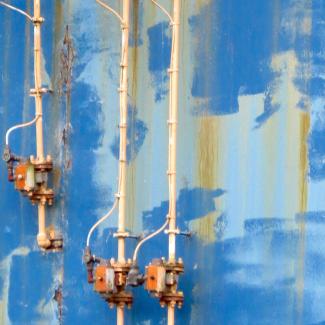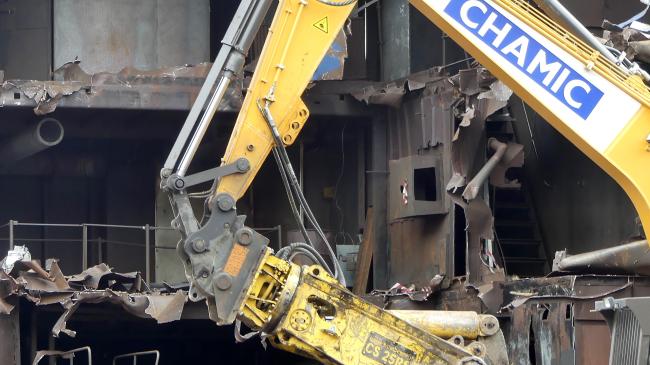
LOCAL LANDMARK DISAPPEARING FAST
It never was Broughton’s most beautiful building, but it was certainly one of the more unusual.
Now, the incongruous-looking training ‘ship’ behind the fire station at 93 McDonald Road is vanishing before our eyes. Demolition began on 18 April and is scheduled to last 4 weeks.
However, at the current rate of progress, we'd be surprised if it takes more than a few days.
The mock-up superstructure, which was erected at the same time as the rest of the fire-station station complex in 1966, has been out of commission for several years now, with firefighters training at alternative centres in Kincardine and Thornton in Fife instead.
Back in 2007, the future of McDonald Road Fire Station looked in doubt, but since the amalgamation of eight Scottish regional services in 2013, it has become a lot more secure.
The demolition work is part of a thoroughgoing ‘refurbishment’ which – subject to planning and budgetary approval – will see the Museum of Fire returning to purpose-built premises here in 2018.

Interesting details about the training facility appear in Graham Kirkwood’s meticulous The History of Scottish Fire Brigades from which the following extract is drawn:
SHIP SECTION:
The predominant part of the chamber is in the form of a modern ship, and was constructed by Messrs. Henry Robb Limited, Shipbuilders, Leith.
The design is as follows:
A. ENGINE ROOM
The engine room, which is fitted with a Mather & Platt MulsiSpray fixed installation, has a Stone Manganese Marine hydraulically controlled watertight door, which leads into the escape shaft tunnel, where a vertical trunk escape ladder is fitted. A remote control for the watertight door is provided on the upper deck. Installed in the engine room are dummy engines, a Drysdale fire pump, humidifier, electrical switchgear and ancillary equipment. Also included is a typical engine room workshop with the normal steel ladders leading to the next deck level within the engine room casing. A Merryweather fire hydrant is installed in the shaft tunnel, and telephonic communication will be fitted to link to the Bridge.
B. FIRST DECK:
On the first deck are the engineers cabins fitted out as for seagoing ships. These are situated outside the engine room casing. The main Mather & Platt sprinkler installation system is also installed at this deck level.
C. SECOND DECK:
The second deck contains a galley and public accommodation, which represents a dining room and lounge. Throughout the ship, corridor and cabin linings are of Marinite fire-resisting panels. In the Saloon the attractive Formica panelling has been provided by Roanoid Limited.
D. BRIDGE DECK:
The Bridge deck contains a typical Bridge, with Wireless Room, Captain’s Sea Cabin, and ship’s binnacle. As far as is practicable, the Bridge is fitted with fire alarms and fire fighting control equipment. On this deck level, engine room skylights are fitted which are capable of being opened both inside and outside the engine room.

E. FIREFIGHTING:
To simulate realistic fire fighting conditions in the ship, heating equipment, a humidifier and smoke generator have been installed. The heating system, ducted from the main station, is so arranged that it can build up to a temperature of 110 F. with 95% humidity. A Merryweather hose reel is fitted to provide fire cover for the accommodation section.
This somewhat novel approach towards the realistic training, not only of fire brigade personnel, but also members of the Mercantile Marine, who can be called upon to fight fires on ships whilst on the high seas and beyond the aid of outside assistance, will greatly add to the experience of members of both Services.
Of all fires, it is generally agreed by fire officers that those which take place on board ship are amongst the most difficult to fight. Almost all ship fires are, in effect, basement fires and have to be approached from above, through the heat and smoke. As this type of fire is about the most difficult to be tackled by professional fire fighters, how then must the untrained Merchant Navy officer or seaman feel when confronted with a fire situation at sea, who has no access to help from professional fire fighters.
In view of the number of fires which take place at sea, unfortunately, a number of which cost human lives, it is to be hoped that many shipping companies will send their staff for training at this new fire school. Industry will not be left out, and courses will be run, mainly using the house section, for the benefit of those who have an executive as well as for persons with a physical responsibility for fire fighting and fire prevention. Certainly something must be done to cut back the appalling fire loss figures which for the past two years have stood at around £77,000,000.
*****
The undermentioned. companies most generously supplied the following equipment and fittings for the ship, as a contribution towards a reduction of fire losses at sea and ashore:
Doors and Linings: Marinite Limited., 25/27 North Row, London Wl
Decorative Formica Linings: Messrs. Rowan & Boden, Limited, Renfrew Road, Paisley
Watertight Doors, Stone Manganese Marine, Limited, Anchor and Hope Lane, London SE7
Sprinklers and MulsiSpray: Messrs. Mather & Platt, Limited, Park Works, Manchester 10
Fire Pump: Messrs. Drysdale & Co., Limited, Bon Accord Works, Yoker, Glasgow W4
Hydrants, Hose Reels and Extinguishers: Messrs Merryweather & Sons, Limited, Greenwich High Road, London SEl0.

Somewhere on Facebook, we’re told, there exists film footage of the day McDonald Road fire station was opened. We can’t find it. Can any reader help? If so, please …
Get in touch at spurtle@hotmail.co.uk or @theSpurtle or Facebook
[Second photo from top: Richard Webb, Creative Commons.]
----------







